Breakfast is at the hotel. It's called "continental," but whatever continent it hails from is not one familiar to me: everything a hungry lumberjack would need is on that continental table and I help myself to juices, fruits, granola, yogurt, bread, salmon and an egg. I had toyed with pre-paying for the more expensive "cooked" breakfast, to last me the day. Ha! Frugality is (finally) rewarded!
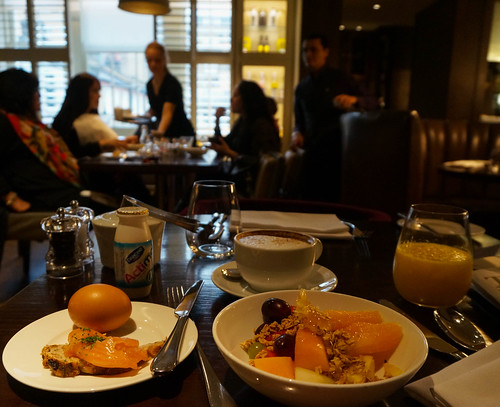
Goodbye, lovely hotel with the TV in the bathtub!

And look! The rain has stopped! The world belongs to the hardy and willing!
I walk rather briskly again. I've purchased tickets for today's travel online, but I have to pick them up at the station. I need time for it. Not many photos for you from this walk then. Just two: one showing that not all cabs here are black and the other -- well it's a hat store display and if I had put it up with the question "can you tell where I am?" I'm sure anyone would have guessed England.
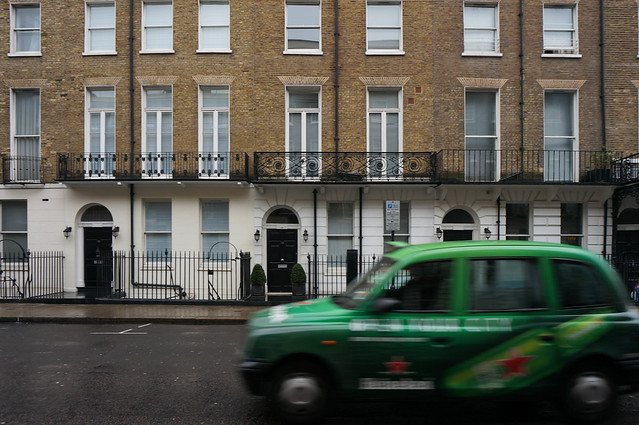

And now I'm at Paddington Station. Here's my train.

It's nearly a five hour ride to the tip of Cornwall (a total of 305 miles to where I'm going) -- the train is high speed until it reaches this southwestern county and then it becomes a local. But my seat is luxuriously comfortable and I have a computer plug and a table and a conductor who tells me that before June, the entire train will have free WiFi. It's spotty now. I must have reacted to that with a pout (not that I need WiFi) because he assures me that the scenery will be quite pretty and I should not ignore it. Though honesty gets the better of him, because he feels compelled to add that this will be the case only once we pass Reading.
In the meanwhile, the cart comes with the warm beverages and snacks. I listen to the passengers putting in their requests. Tea, room for milk, again and again. One asks for biscuits, another for fruitcake. I have never before heard anyone willingly ask for fruitcake. Yes, I am in England.
I so love train travel.
I have time for the paper. I learn in the Times that there is a national discussion taking place on whether the new requirement that students memorize up to 15 poems by heart for their GCSE English literature exams (16 year olds take these) is a good idea (you wont be able to bring in an anthology for the requisite analysis -- you must remember the poems to write about them). Jane Weir, whose poem "Poppies" is on the exam syllabus is saying no: memorize poems you like, not because you have to! But Seamus Heaney (the Irish poet who received the '95 Nobel Prize in literature) is in support: it's the beginning of a cultural ear!
You can read "Poppies" here. It was commissioned for The Guardian, as part of a response to the escalating conflict in Afghanistan and the Iraq. Weir commented in an interview that, ‘I wrote the piece from a woman's perspective, which is quite rare, as most poets who write about war have been men. As the mother of two teenage boys, I tried to put across how I might feel if they were fighting in a war zone.’ It's not a short poem. I should think it would be hard to memorize.
In other news, you might be interested to know that between now and the national elections (picking the P.M.) on May 7th, the British can cast a vote for a national bird. Polls indicate that the robin is a favorite. However, David Lindo, the guy who leads the National Bird Campaign (his claim: the Americans have the eagle, the French have the rooster, it's time for Britain to have a bird!), thinks the hen harrier, which is on the verge of extinction could come in from the back. He himself is hoping for the blackbird, whose song evokes "lazy, hazy sunny days." Other birds on the short list are (derived from a previous vote): barn owl, kingfisher, blue tit, wren, puffin, mute swan and red kite. Personally I'd go for the puffin, with the blue tit -- in its lovely blue and yellow -- being my close second. You can inspect the birds and read the Guardian's version of this story here.
Too, there is a campaign to eradicate the gray squirrel in Britain, an unwelcome American intruder who, it is said, "belongs in the oak and hickory forests of North America," not here. That's a gory story. I'll leave it to your imagination how such a campaign, in a country where there are four or five million American grays (and only 100,000 reds left) might proceed.
And so the train rolls into Cornwall.
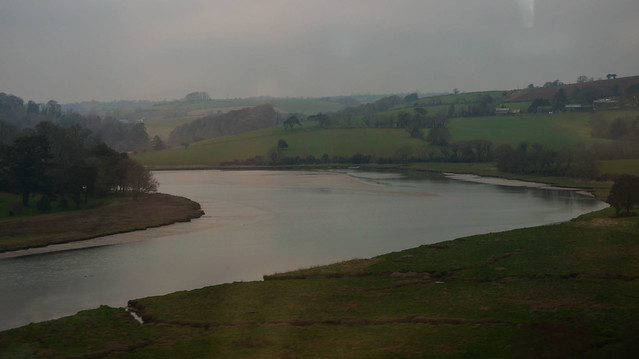
In St. Erth, I change for the little train to St Ives.

St Ives.
As I was walking to St. Ives, I met a man with seven wives.
Each wife had seven sacks,
Each sack had seven cats,
Each cat had seven kits:
Kits, cars, sacks, wives,
How many were going to St. Ives?
Am I the only one who remembers this nursery riddle?
But the question remains: which St. Ives does it refer to? Because there are a number of towns with that name in England! Half the nation believes it's about the St. Ives in Cornwall. This once was (and to an extent still is) a fishing village and so the reference to cats is understood. On the other hand, the St. Ives in Huntingdonshire is a huge market town and so that, too, makes it a fit.
As to how many were going to St. Ives? Well, who knows? At least one, possibly a hell of a lot more, depending on where everyone else was heading.
St. Ives: population 11,200. Named "best UK seaside town" in the last several years. It is on the Celtic Sea coast of the western and southern most tip of England. If you walk due west from it, you'll reach in about 25 miles Land's End and then you really are at the land's end.
I am at the Mountain Warehouse (a British sporting attire store), buying a thin fleece pullover to go under my fleece jacket. My hosts suggested it. On sale for twelve pounds. I took one walk on the coastal path and decided enough is enough. The sea wind is gusty and even if I only use it this one day, I know that it packs well and is a good thing to stick in my suitcase in these shoulder travel times. A much better idea than taking a warmer jacket. I say to the clerk (who looks like he'd rather be surfing) -- St Ives looks to be doing well! I'm impressed that on the main shopping street, the shops, bakeries, eateries are all open. No closed and shuttered storefronts here. Fresh coats of paint on buildings.
The salesclerk shrugs. The people who come here are doing well. We locals, we're struggling. The season is two months long. By the end of winter, we don't have any money.
But I think there must be some variation to this. My (newly opened two years ago) guest house is fully booked. The place where I eat dinner is full as well and the waitress tells me that from Easter onwards, they wont have a quiet night.
Still, the clerk has a point: St. Ives is just a tiny bit upscale. I'm told it's a favorite for Londoners and Germans. You don't put a local branch of the Tate Museum (yes, here since 1993) in a hole in the wall. (The Tate, aside from its two London galleries, has this St Ives one and another regional gallery in Liverpool.) And St. Ives is not cheap: I had wanted to spend a week here, but after looking at the prices, I cut it to four days. I should note that the bed and breakfast -- the Trevose Guest House, is so worth it! It's beautiful!
And here's another thing that's absolutely stunning: the scenery. Oh, the views! I catch a glimpse on the little train -- a ten minute coastal link, running back and forth between St Erth and St Ives. I take photos, but then erase them all because I know I'll have better ones once I'm out and walking.
From the St. Ives train station (if you can call it that) it's just a four minute hop over to the Guest House. It's rather conventional on the street side...
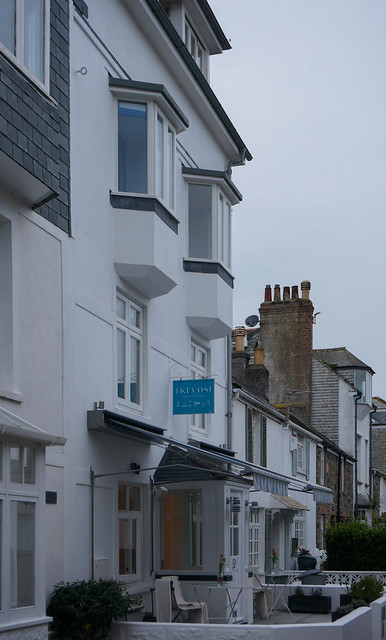
But inside, you really catch your breath: it's all about blue and white here and the spaces are light and airy.
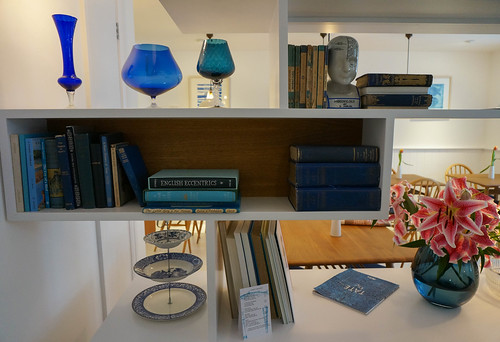

I come at a time of a flurry of activity: the owners, Angela and Ollie, are off for their first ever parent teacher conference (they have a four year old girl; I ask them later how it went -- brilliant! the teacher says she's brilliant! Ollie grins, understanding fully well that she may not be the only one in class with that designation). Their assistant at the guest house checks us in. I say "us" because just at this moment, a couple from Alabama drive up. They are on a fiftieth wedding anniversary trip and they seem despondent. She trips on a step and her mood never improves after that. She admits that they had a few frustrating words as they couldn't find the guest house and yes, it's a long drive from London.
Me, I am in no hurry, so I let the inn keepers attend to the unhappy celebrators first. I sip an offered tea in the breakfast room and look around.

Everything about this place appeals to me. It still smells fresh, as if I am in its opening moment.
Eventually I am shown to my room -- which I picked because it was the cheapest, but also the most perfect for me. As they explain - it is the only room in the house where you can lie in bed and look out on the sea.
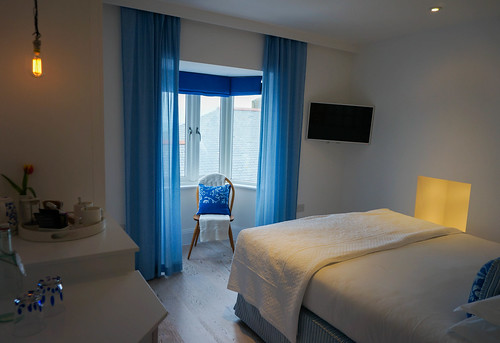
The view:

And now it is 4 p.m. and I am outfitted with my additional layer and I am raring to go. No ambitious hike for today: just a walk east (meaning back toward St Erth) along the coast.
I leave the town, noting that others aren't so put off by the still mid forties temps (they're coming in from a day of surfing).

Well, let me walk briskly. Ah, but that extra layer is good! The feeling of cold is completely gone, despite the wind. And I am in England and the English are perhaps the best in Europe at marking walking trails. They are such keen and spirited walkers! I pick up the coastal trail.
The views are tremendous every which way you look.

I walk down to the water's edge. A stream runs into the sea here, creating sand formations of different tones and hues. Colorful bath houses line the edge.

Along the trail itself, I come across the spring blooms -- some in the wild, some cultivated by the locals.

It is an exhilarating walk! Even if today I'm still under gray skies -- I have no complaints!
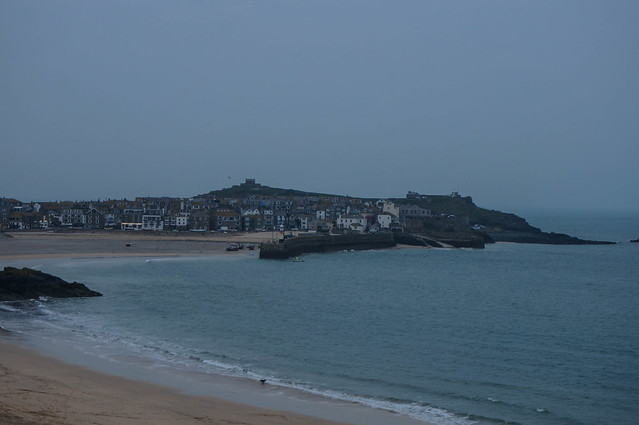
What I do have is a raging appetite. Again, breakfast seems far in the past. I let the guest house hosts pick the restaurants for me. My criteria are simple: fresh and honest food, not too expensive or stuffy. For tonight, they send me to the Sea Food Cafe.

Here, you pick your catch from their day's selection and they prepare it for you as you want it. The sea bass, grilled, with a Mediterranean sauce (their description) of red peppers and garlic. And a large salad. Oh, and a few local scallops to start me off. (No need for dessert. I'll save that for France.) I am in sea food heaven.
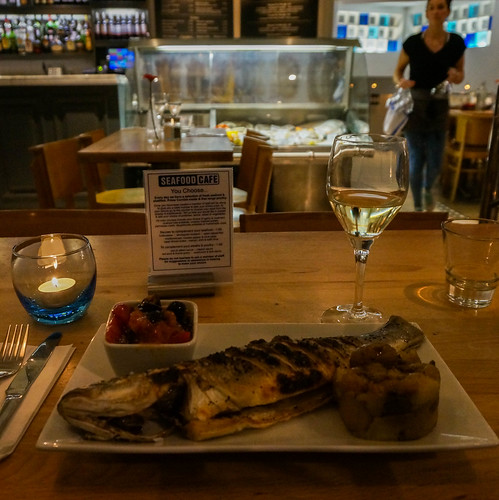
Later, as I lie in bed and listen to the noise of the sea gulls, I think about what it must feel like to live in England but really far from London. Berwick upon Tweed (last June's trip for me), on the Scottish border, is arguably further at 338 miles (St Ives, as I noted, is 305), but it is close to any number of larger cities. Cornwall has the feel of a more remote destination. At the St Erth station, I made my way to the tiny waiting room, because even the fifteen minute wait outside for the train was too cold for me. A young woman was there as well.
I stand by the radiator here when it gets too cold outside: it's the best spot to wait for the train, she tells me.
She looks to be around forty. I ask her if she is from here.
Yes, I live right by St Ives. That is, I moved away for a number of years, but then I came back. Now I can't imagine living anywhere else.
I get it. Even after only one late afternoon and evening here, I understand why she wont ever leave.

